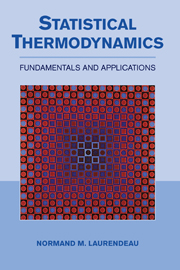Book contents
- Frontmatter
- Contents
- Preface
- 1 Introduction
- PART ONE FUNDAMENTALS OF STATISTICAL THERMODYNAMICS
- PART TWO QUANTUM MECHANICS AND SPECTROSCOPY
- PART THREE STATISTICAL THERMODYNAMICS IN THE DILUTE LIMIT
- PART FOUR STATISTICAL THERMODYNAMICS BEYOND THE DILUTE LIMIT
- PART FIVE NONEQUILIBRIUM STATISTICAL THERMODYNAMICS
- PART SIX THE ENSEMBLE METHOD OF STATISTICAL THERMODYNAMICS
- 18 The Canonical and Grand Canonical Ensembles
- 19 Applications of Ensemble Theory to Real Gases
- Problem Set VIII Ensemble Theory and the Nonideal Gas (Chapters 18–19)
- 20 Whence and Whither
- PART SEVEN APPENDICES
- Index
20 - Whence and Whither
Published online by Cambridge University Press: 05 June 2012
- Frontmatter
- Contents
- Preface
- 1 Introduction
- PART ONE FUNDAMENTALS OF STATISTICAL THERMODYNAMICS
- PART TWO QUANTUM MECHANICS AND SPECTROSCOPY
- PART THREE STATISTICAL THERMODYNAMICS IN THE DILUTE LIMIT
- PART FOUR STATISTICAL THERMODYNAMICS BEYOND THE DILUTE LIMIT
- PART FIVE NONEQUILIBRIUM STATISTICAL THERMODYNAMICS
- PART SIX THE ENSEMBLE METHOD OF STATISTICAL THERMODYNAMICS
- 18 The Canonical and Grand Canonical Ensembles
- 19 Applications of Ensemble Theory to Real Gases
- Problem Set VIII Ensemble Theory and the Nonideal Gas (Chapters 18–19)
- 20 Whence and Whither
- PART SEVEN APPENDICES
- Index
Summary
We have come a long way together on this journey through the intricacies of statistical thermodynamics. Did the voyage meet your expectations? Were there any surprises along the way? While such questions are part and parcel of any journey, sober reflection on your itinerary offers convincing evidence that macroscopic thermodynamics can indeed be built on a solid foundation of microscopic thermodynamics. More importantly, you have surely found that new insights, deeper understanding, and novel applications follow from a statistical approach to basic thermodynamics. In this concluding chapter, we review highlights from our journey and muse on future experiences awaiting you in the realm of statistical thermodynamics. A significant outcome of this first excursion is that you are now prepared for many new journeys to come. I encourage you to be open to this further understanding and to explore the multitude of evolving venues which seek to exploit both the fundamentals and applications of statistical thermodynamics.
Reprising the Journey
We began our quest by introducing the two basic postulates of statistical thermodynamics: the ergodic hypothesis and the principle of equal a priori probability. The first postulate asserts that any thermodynamic variable characterizing an isolated system of independent particles can be evaluated by suitably averaging over all possible microstates, that is, over all feasible distributions of particles among energy states. The required statistical perspective is encapsulated by the second postulate, which holds that all microstates are equally likely.
- Type
- Chapter
- Information
- Statistical ThermodynamicsFundamentals and Applications, pp. 379 - 386Publisher: Cambridge University PressPrint publication year: 2005



